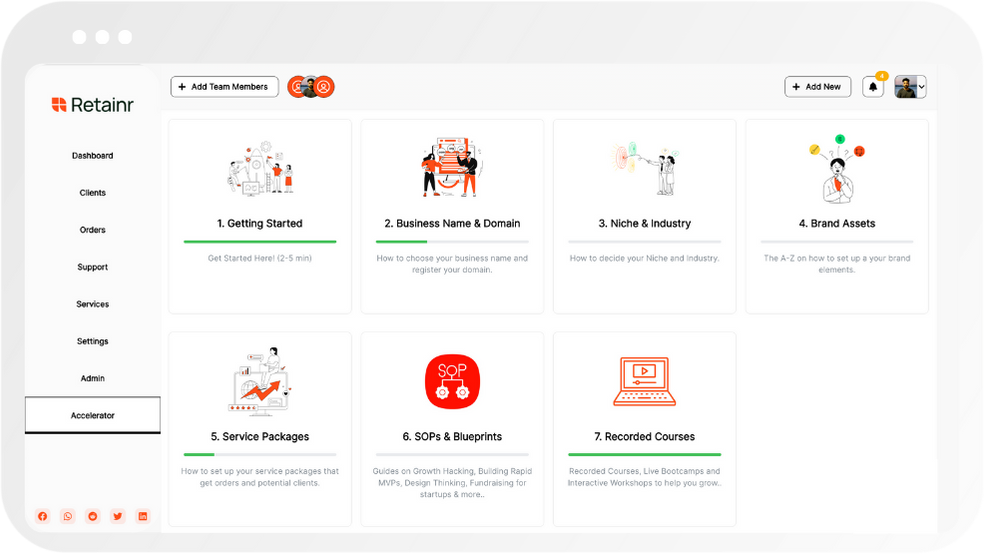
8 Steps to Implement a Social Media Marketing Strategy
Build with Retainr
Sell your products and services, manage clients, orders, payments, automate your client onboarding and management with your own branded web application.
Get Started1. What are the 8 steps to implement a social media marketing strategy?
Step 1: Set Clear Objectives and Goals
Defining what you want to achieve with your social media marketing will guide your strategy. Your goals need to be SMART (Specific, Measurable, Achievable, Relevant, and Time-Bound). Some common social media goals include improving brand awareness, driving traffic to your website, generating new leads, and boosting product sales.
Step 2: Understand Your Target Audience and Competitors
Understanding who your target audience is and what they want to see on social media is key. It can help you create content that they will like, comment on, and share. It's also crucial to stay up-to-date with the competition. You should be interactive with your audience and responsive to their needs and reviews. Here are ways to understand your audience and competitors:
- Determine who your target customer is (what are their interests, age, gender, etc.).
- Investigate your competitors (what strategies are they using, which ones are working, why are they working).
Step 3: Plan and Create Engaging Content
Content is an essential part of your social media marketing. You need to devise a content marketing strategy to plan for what you'll share. Balance your content to be informative, helpful, and shareable with just enough promotional material.
| Content Type | Example | Purpose |
|---|---|---|
| Informative | Industry news, educational posts, "how-to" guides | To educate the audience, build trust, attract organic traffic |
| Helpful | Tips, tricks, hacks, problem-solving content | To help your audience, provide value, build brand credibility |
| Shareable | Inspirational quotes, funny memes, viral videos | To entertain, engage the audience, boost social shares, improve brand visibility |
| Promotional | Product demos, special offers, announcements | To promote your offerings, drive sales, communicate with customers |
2. Why is it important to set measurable goals in your social media marketing strategy?
Importance of Setting Measurable Goals
Setting measurable goals is essential within the realm of social media marketing strategy because they serve as guiding posts, ensuring your marketing efforts align with your broader business objectives. Goals not only help to compare performances but also motivate teams to strive for better results.
- Alignment with Business Objectives: Measurable goals eliminate ambiguity and provide specific metrics that your business aims to achieve. These might be revenue-based, such as a particular sales target, or non-financial, such as reaching a certain number of followers. Aligning social media marketing efforts with business objectives allows for a unified approach towards achieving organisational success.
- Benchmarking Performance: Measurable goals serve as yardsticks for evaluating the effectiveness of your social media marketing strategy. It enables you to identify trends, measure progress, and adjust your strategy as necessary to maximize the impact of your marketing efforts. Without these metrics, you might be wasting resources without realizing it.
- Motivating Teams: Clearly defined and measurable goals inspire team members and keep them focused. These objectives provide a sense of direction and an understanding of what is expected which, in turn, boosts productivity and fosters a culture of accountability.
Tables to Illustrate Measurable Goals in Social Media Marketing
A clear understanding of measurable objectives can be achieved by systematically categorizing goals according to a few divisions, such as goal category, specific metric, and the social media platform.
| Goal Category | Specific Metric | Social Media Platform |
|---|---|---|
| Increase Brand Awareness | Number of Followers | Instagram, Twitter |
| Enhance Customer Engagement | Likes, Comments and Share Rate | Facebook, Linkedin |
| Drive Website Traffic | Click Through Rate (CTR) | All Platforms |
By delineating goals in such a structured manner, businesses can markedly improve the effectiveness of their social media marketing, ensuring it contributes meaningfully to their overall growth trajectory.
3. What are some examples of specific social media platforms to use in a marketing strategy?
Popular Social Media Platforms for Marketing
Businesses have a myriad of social media platforms to choose from when formulating their marketing strategies. Some of the most prevalent platforms include:
- Facebook: This is a well-rounded platform with a diverse user base, making it a perfect choice for businesses targeting a variety of demographics. Its business-friendly features such as Pages, Groups, and Ads, make it a favorable platform for marketing strategies.
- Instagram: Ideal for businesses with strong visual content, especially within the fashion, lifestyle, and food industries. Instagram Stories, posts, IGTV, and Reels offer multiple ways to engage users.
- Twitter: This platform suits timely, relevant updates and interactions with its fast-paced news feed and supports direct communication with users via tweets and direct messages.
- LinkedIn: Best suited for B2B companies, LinkedIn allows businesses to build professional relationships, find leads, and share industry-relevant content.
Choosing a Platform Based on Business Needs
Choosing the ideal platform depends on the nature of the business, the target audience, and the type of content. The table below provides an overview:
| Social Media Platform | Suited for Business Type | Content Type |
|---|---|---|
| All-round, diverse demographics | Image, Video, Text, Ads | |
| Fashion, Lifestyle, Food | Visual - images, videos | |
| News, Customer Service | Quick, timely text updates | |
| B2B, Professional Services | Professional, Industry Relevant Content |
Utilizing Multiple Platforms
While focusing on a single platform depending on your primary demographic might be beneficial, an effective social media marketing strategy often involves utilizing multiple platforms. This comprehensive approach can ensure maximum visibility, engagement, and impact. Remember, the goal is to meet your audience where they already are, offering them appealing and engaging content that aligns with your brand identity and business goals.
4. How much time should I expect to dedicate to implementing a social media marketing strategy?
Understanding Time Investment in Social Media Marketing Strategy
Implementing a social media marketing strategy requires a significant amount of time and commitment. While the exact duration varies depending upon the size of your business, the complexity of your strategy, and your familiarity with social media platforms, you can expect to typically invest a substantial amount of initial time followed by regular maintenance hours. For convenience, let's break down the average time investment pattern:
- Research & Planning: 10-15 hours
- Setting Up Profiles: 2-4 hours per platform
- Content Creation: 5-7 hours per week
- Engagement & Community Management: 10-12 hours per week
Elaborating Time Frames for Each Step
Let's dive into the specifics of time allocation for each step. Initial research and planning involve understanding your audience, studying competitors, and developing your unique value proposition. Setting up profiles is a one-time task but includes creating optimized descriptions and graphics for each platform. Content creation is a recurring task and involves developing engaging posts, graphics, and videos. Engagement is also continuous, including responding to comments, participating in relevant discussions, and analyzing performance.
| Task | Approximate Time Required |
|---|---|
| Research & Planning | 10-15 hours |
| Setting Up Profiles | 2-4 hours/platform |
| Content Creation | 5-7 hours/week |
| Engagement & Community Management | 10-12 hours/week |
Continued Investment in Social Media Marketing
Enduring success in social media marketing requires ongoing time investment. Even after the strategy is implemented, you need to dedicate time to maintain your profiles, create fresh content, engage with your audience, and test new strategies. Remember that consistency is key - regular activity on your profiles will keep your audience engaged and help you build a strong online presence. Consider investing in social media scheduling tools or hiring a social media manager if the time commitment becomes overwhelming.
5. Why is it important to research my competition as part of my social media marketing strategy?
Importance of Competitive Research in Social Media Marketing Strategy
Conducting a thorough competition analysis can provide invaluable insights that could contribute significantly to the success of your social media marketing strategy. This is because, understanding how your rivals are performing and what strategies they are implementing can help inform your decisions, shape your own approach and enable you to identify opportunities for improvement.
- Identify strengths and weaknesses: By monitoring the social media activity of your competitors, you can identify their strong points and exploit their weaknesses to gain a competitive edge. For example, if competition isn't engaging their audience enough, you can fill that gap with a more interactive strategy.
- Discover successful strategies: Analysing your competition’s successes can give you ideas for your own strategies. You can learn from their effective tactics and potentially apply similar techniques.
- Stay ahead of trends: Your competition may be using strategies or exploring trends that you aren't aware of. By keeping an eye on them, you can ensure you're not left behind in the constantly evolving social media landscape.
To make the process more streamlined and effective, it can be beneficial to present your findings and observations in a structured table format, such as the one below.
| Competitor | Strengths | Weaknesses | Opportunities |
|---|---|---|---|
| Competitor 1 | High engagement | Infrequent posting | Post more frequently |
| Competitor 2 | Wide customer base | Poor customer service online | Ramp up customer service |
6. How do I define my target audience when creating a social media marketing strategy?
Defining Your Target Audience
The first step in defining your target audience in a social media marketing strategy is to understand who your current customer base is. Use site analytics, customer feedback, and other insights to help you build a 'customer avatar'. This avatar is a representation of your ideal customer and will include demographic data, lifestyle, behaviors, and preferences. This information will help you target your social media efforts to the right audience.
- Analyze your current customers: Use your website or social media analytics to understand your existing customer base.
- Study your competitors: Look at who is engaging with your competitors' content to see if there may be a potential audience you might have missed.
- Conduct market research: Utilize surveys and interviews to gain a comprehensive understanding of your potential target audience.
Segment Your Audience
Once you have defined your general audience, the next step is to segment it into distinct groups. These segments could be based on age, location, interests, etc. Segmentation will make your social media marketing more personalized and effective. This gives you an idea of how to tailor your messages to each group. After segmenting your audience, it is crucial to prioritize each segment according to their potential value to your business.
| Segment | Characteristics | Priority |
|---|---|---|
| Young adults | 18-24 years, Students, Tech-savvy | High |
| Working adults | 25-50 years, Professionals, Frequent social media users | Medium |
| Seniors | 51 years and above, Less tech-savvy, May require more assistance | Low |
Test and Adjust Your Segments
The final step in defining your target audience is testing your segments. Utilize A/B testing to see which audience responds best to your social media marketing. Based on these results, you can fine-tune your segments and adjust your strategy as needed. Remember, your target audience may change over time. So, regularly revisit and revise your audience segments to ensure you're always targeting the right people.
7. What are the key components of a successful social media marketing strategy?
Key Components of a Successful Social Media Marketing Strategy
There are several crucial elements that make a strong social media marketing strategy. Understanding these key components can be the difference between an effective approach that boosts brand presence and an ineffective strategy that wastes valuable resources.
- Target Audience: Before creating any content, you have to identify your target audience. It is essential to understand their preferences, behaviors, and what types of content they engage with the most.
- Content Creation: This is the backbone of your social media strategy. You need to create compelling content that aligns with your brand and engages your audience. This can range from images and videos, to blog posts and infographics.
- Consistency: Consistency in posting is key for maintaining an active and engaged audience. Set a schedule for your posts and stick to them.
- Engagement: Engaging with your audience, either through comments, direct messages or shared stories helps to build a strong relationship with your audience.
Below is a table summarizing these important elements:
| Element | Description |
|---|---|
| Target Audience | Identifying and understanding the preference, behaviors and types of content your audience engages with. |
| Content Creation | Creating compelling content that aligns with your brand and engages your audience. |
| Consistency | Maintaining a regular posting schedule to keep your audience engaged. |
| Engagement | Interacting with your audience to build strong relationships. |
In addition to these key components, it's also important to continually evaluate and adjust your strategy based on results. By using social media analytics tools, you can gain insights into how well your content is performing and make improvements where necessary.
8. How do I measure the success of my social media marketing strategy?
Defining the Metrics to Measure Success
Determining whether your social media strategy is successful involves pre-defining specific metrics that align with your goals. These can include:
- Engagement: This involves tracking likes, comments, shares, and overall engagement rates.
- Reach: The number of unique users who see your content.
- Impressions: Total number of times your content is displayed regardless of clicks.
- Followers: The number of people following your social media profiles. Increasing followers denotes growing brand awareness.
- Web Traffic: The number of visitors redirected to your website from your social media channels.
Using Analytics Tools for Measurements
Multiple social media platforms offer in-built analytics tools to help measure these metrics. For instance, Facebook Insights, Instagram Insights, and Twitter Analytics. Furthermore, Google Analytics can be a useful tool to measure the success of your social media marketing strategy in driving traffic to your website. Small tools like UTM codes can also be useful in tracking the traffic from each platform.
Evaluating Success with a Comparative Analysis
The success of your social media marketing strategy should also be evaluated using a comparative analysis over time. The table below illustrates a basic framework you could use:
| Metrics | Current Status | Goal | Performance Over Time |
|---|---|---|---|
| Engagement | [Current Status] | [Goal] | [Performance Over Time] |
| Reach | [Current Status] | [Goal] | [Performance Over Time] |
| Impressions | [Current Status] | [Goal] | [Performance Over Time] |
| Followers | [Current Status] | [Goal] | [Performance Over Time] |
| Web Traffic | [Current Status] | [Goal] | [Performance Over Time] |
9. Can you provide tips on how to create engaging content for my social media marketing strategy?
Creating Engaging Content for Social Media Marketing Strategy
Creating engaging content is a critical part of any successful social media marketing strategy. You need to consistently create posts that encourage likes, shares, and comments to build your brand's online presence and engage with your audience. Here are some tips on how to create captivating content:
- Research your audience: Understand who your audience is and what they are interested in. Use analytics tools to understand their demographics, interests, and online behaviours.
- Create valuable content: Useful and informative content is always appreciated. Provide tips, advice, and insights that your audience will find valuable.
- Use visuals: Use pictures, videos, infographics, and GIFs to make your posts more interactive and engaging.
- Encourage interaction: Ask questions, create polls, and encourage your followers to interact with your posts.
Types of Engaging Content Formats for Social Media Marketing
The type of content you create also plays a big role in how engaging it will be. Different types of content formats appeal to different audiences. Knowing which formats are most popular with your audience can help you create more engaging content. Here is a simple table listing some of the most popular content formats and their uses:
| Type of Content | Best Use |
|---|---|
| Images | Visual representation of your products or services, behind the scenes, infographics, etc. |
| Videos | Tutorials, unboxing, product demonstrations, live videos, etc. |
| User-generated content | Testimonials, reviews, user experiences with your product/service, etc. |
| Text posts | Quotes, tips, fun facts, questions, etc. |
Optimize Your Content for Each Social Media Channel
Each social media platform cater to different audiences and work well with different types of content. Therefore, it's essential to optimize your content for each social media channel. Below are some platform-specific tips:
- Facebook: With a versatile platform like Facebook, you can use a mix of text, images, videos, and links. Remember to keep your posts informal and conversational.
- Instagram: Instagram is all about visuals, so high-quality images and short videos work best. Also, don't forget to use relevant hashtags.
- Twitter: Twitter is great for short, snappy updates and conversations. Include images, gifs, and links in your tweets to make them more engaging.
- LinkedIn: On LinkedIn, relevant industry news, informative blogs, and company updates get the most engagement.
10. How important is it to regularly review and adjust my social media marketing strategy?
Importance of Reviewing and Adjusting Your Social Media Marketing Strategy
The necessity of regularly reviewing and adjusting your social media marketing strategy cannot be overstated for several reasons. First, it enables you to keep up with the dynamic nature of social media platforms, as they frequently introduce new features and algorithms that could impact your strategy. Furthermore, it provides insights into your audience's evolving preferences and online habits, allowing you to modify your strategy to match. Thirdly, it helps establish what's working and what's not, enabling you to optimize your plan for better results.
Key Measures to Review in Your Strategy
- Audience engagement: Monitor likes, comments, shares, retweets, and other interactions. Make adjustments to promote further engagement.
- Reach and impressions:Evaluate how far your posts are spreading and identify which posts reach the most people.
- Website traffic: Observe how much traffic is generated to your website from social media platforms. This includes looking at bounce rates and conversions.
- Follower growth: Keep track of the rate at which your followers are increasing. A slow growth rate may indicate a need to adjust your strategy.
- Content performance: Assess which types of content are performing the best. This can guide future content creation.
Periodic Evaluation of Your Social Media Marketing Strategy
| Period | Reason | Action |
|---|---|---|
| Weekly | To monitor the performance of your posts and observe any significant changes. | Make prompt content adjustment based on post performance. Plan ahead for the next week. |
| Quarterly | To assess broader strategic goals, audience growth and engagement trends. | Update overall strategy and redefine goals if necessary. Retarget your audience as needed. |
| Annually | To review the overall efficacy of your social media strategy, alignment with business strategy and market trends. | Revise and plan a new or adjusted strategy for the next year. |
Conclusion
Summarising '8 Steps to Implement a Social Media Marketing Strategy'
Incorporating a social media strategy is crucial for a business to thrive in today’s digital world. Here are 8 steps to ensure success:
- Set Clear Objectives: Initially define your social media marketing goals.
- Identify Target Audience: Understand who your optimal consumers are and what they need.
- Research Competitors: Learning from rivals can give valuable insights.
- Select Suitable Platforms: Choose social media platforms that align with your business model.
- Create Engaging Content: Quality content is key to engage and retain your audience.
- Engage with your Audience: Interaction fosters community and loyalty.
- Analyse and Adjust: Regularly monitor performance and adjust strategies as necessary.
- Invest in Social Media Management Tools: Utilize the right tools to streamline and maximize social media activities.
Streamline your Social Media Marketing with Retainr.io
When it comes to effective social media management, Retainr.io should be your go-to tool. It is a white-label software uniquely designed to handle sales, manage clients, process orders, and facilitate payments within your brand's bespoke app.
Retainr.io simplifies social media marketing by allowing you to organize, track, and manage all your marketing efforts from a single platform. Whether you're setting clear objectives, doing research on your competition, or engaging with your audience, Retainr.io helps you succeed at every step of your social media marketing strategy.
So why wait any longer? Revolutionize your social media marketing strategy with the top-notch services provided by Retainr.io.
Boost Your Agency Growth
with Retainr Accelerator
Uncover secrets, strategies, and exclusive blueprints to take your agency's growth to the next level — from marketing insights to effective presentations and leveraging technology.

SOPs, Cheatsheets & Blueprints
Leverage 50+ SOPs (valued over $10K) offering practical guides, scripts, tools, hacks, templates, and cheat sheets to fast-track your startup's growth.
Connect with fellow entrepreneurs, share experiences, and get expert insights within our exclusive Facebook community.
.jpg)

Join a thriving community of growth hackers. Network, collaborate, and learn from like-minded entrepreneurs on a lifelong journey to success.

Gain expertise with recorded Courses, Live Bootcamps and interactive Workshops on topics like growth hacking, copywriting, no-code funnel building, performance marketing and more, taught by seasoned coaches & industry experts.

.jpg)

.jpeg)


